In: Russian Artists
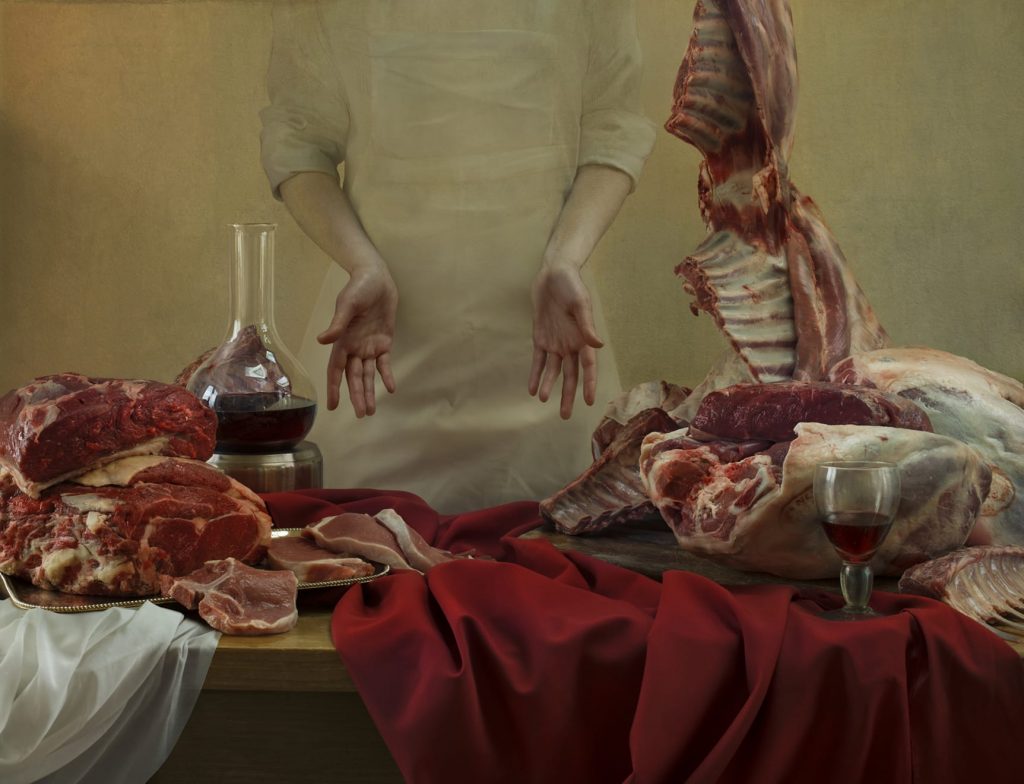
Katerina Belkina | The Dinner, 2016
February 15, 2024Katerina Belkina | The Dinner, 2016 (from the series Repast)
(Photography, Digital Painting)
“God sendeth and giveth both mouth and the meat.”
(Thomas Tusser, 1524 – 1580)
I will admit that there are certain fascinations (or perhaps less charitably or more directly classified) obsessions that ‘feed’ my interests in terms of artworks.
Meat – and how many artists employ flesh as inspiration or subject – is one of them. I offered a previous essay (centered on the fine paintings of Scott Conary) that explored this, but when I was making artworks prior to my exile or migration to Niagara (edit as you will) I often worked with fat, meat, bones and other organic matter, to make works that I described as ‘inappropriately beautiful.’
Sometimes, amidst the cacophony – or idiot choir – of ‘art criticism’ these days, with references pedantic and claiming to be ‘philosophical’ it is good to return to simply a notion of beauty. One of my best teachers, Patrick Traer – a fine artist whose work dealt with these contested, perhaps conflicting, narratives – spoke of this to me years ago, when I was still on the Prairies.
Belkina’s artwork that I share here is gripping, and perhaps inappropriately (to some weaker constitutions) beautiful. She offers some interesting ideas about her motivation and ideas that sometimes intersect with my own subjectivity, but this is an image that is striking and that, frankly, is enough.
Her religious connections are not of particular interest to me : but I must admit that my own religious upbringing (or indoctrination) have sometimes directed my interests, too – and there is a fecundity of potential interpretations that contest or converge that make her work worthy of consideration, whatever your pre existing assumptions (and I include myself in this statement).
From her site :
“Repast is an allegory of life cycles. Cyclicity perfectly characterizes humanity and our perception of time.
The Morning (childhood) means acquisition and accumulation. At the beginning of life we receive a certain foundation and potency both from our family and from the society in which we live. We learn to recognize the beauty around us and to feel it — we use all this for the rest of our lives. Even if “breakfast” is sparse in physical reality, it is often filled to the brim with intangible treasures such as love, fantasy, discoveries, strong impressions and first disappointments. In “breakfast” the abundance of dairy products is symbolic. The milk is associated with purity and virginity. The memories of breast milk are still fresh. The fullness you see is an exaggeration. The yellow of orange juice symbolizes concentrated emotions, the taste of life, sincere joy, and the energy of children. A lemon or an orange signifies the unquenchable thirst for action, knowledge, and discovery.
The Day (youth, adulthood) — creation, destruction, giving and taking. The flesh (the fruit) and the colour red are symbols of life and sacrifice. Youth is a period of expending — some build, others destroy. “Time to throw stones and gather stones” — there is a balance in this. We all make sacrifices and give everything at this point in our lives. More or less.
The Evening (age, completion) — contemplation, silence. A meditative part. Scarcity of dinner does not mean scarcity of life, or poverty. The table is set for one person. We come alone to the end of our lives, and yet we merge face to face with the divine in this world. It is a time of transition where all matter fades and loses all meaning. I believe our spirit reaches its peak here and we either accept or reject this transition completely. The set of elements depicted is simple: the fish is the symbol of Christ, the potato (the second bread) — the body losing the spirit (steam), the black tea — the drink of the gods and sages, not for simple thirst quenching, but for contemplation. The position of the hands in the triptych refers to Leonardo da Vinci’s “Last Supper”, in which the master emphasized the hands. Here they recede into the background and invite the viewer into this or that phase of life — past or future.”
Katerina Belkina was born in Samara in the southeast of European Russia : her mother was also a visual artist. Belkina attended the school for Photography of Michael Musorin in Samara and she’s exhibited her work in Moscow and Paris. In 2007 Katerina Belkina was nominated for the prestigious Kandinsky Prize (comparable to the British Turner Prize) in Moscow, and she has also been awarded the Hasselblad Masters Prize. She lives and works in Werder (Havel) near Berlin.
More of her work can be enjoyed here and here.
~ Bart Gazzola
Read More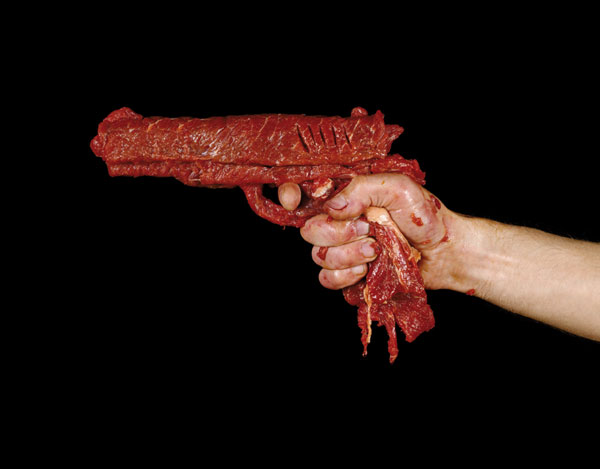
Dimitri Tsykalov | MEAT | 2007 – 2008
July 28, 2023Dimitri Tsykalov | MEAT | 2007 – 2008
It’s not a new idea that firearms make acts of violence ‘too easy’, almost ‘antiseptic’, as they minimize the necessary physical contact intrinsic to other acts of brutality. This is an idea that’s been raised about technology since we began using it to kill each other.
(At the risk of seeming flippant, I must also inject a quote that came to mind when I first encountered images of Tsykalov’s MEAT : Invariably, the first question asked about a new technology is, “Can this make killing less of a hassle?” The second being, “Can I have sex with it?”…)
The implicit ‘removal’ or ‘remoteness’ (I’m reminded of the ski pole scene from Timothy Findley’s The Wars, for example, where the firearm and act of murder almost seem separate from the character himself) makes it almost a ‘trivial’ or ‘throwaway’ action to fire a gun.
Dimitri Tsykalov’s MEAT works offer a counter to that, in a grotesque manner that is excessive : I’ve debated writing about Tsykalov’s ‘armaments’ for a while, unsure if they’re too flippant, or too horrifying, or a combination of both that is as unpalatable as gripping cold flesh while your hands are stained and overrun with effluvia…
These works don’t pretend to an aesthetic distance (like in Serrano’s work, or some other artists I’ve talked about here who – like myself, when I worked with fat, bone and meat for over two decades – are interested in creating inappropriately beautiful artwork) : I feel that Tsykalov takes pleasure in our revulsion and wants to evoke it from us, and considering what he’s ‘butchering’ the meat, flesh and bone into, this is not inappropriate. There’s a swagger here, a bravado that intends to make us ill. Meat and guns are, after all, metaphors for penises or toxic masculinity, and Tsykalov alludes to that (even with the titles that reference specific guns).
Tsykalov, in creating work that intersects with brutality and our capacity for it, as a species, has taken an opposing artistic path to someone like Ralph Ziman with The Ghosts Project (a past Curator’s Pick you can see here).
Tsykalov’s own words : “In these pictures I recognize the murderers within me, I recognize love and death within me; in these pictures I recognize my flesh as the cannon fodder it is and will be for the rest of my life. In contrast the secondary meat in these shots – the one that rots and that kills, the animal meat that is used to create the fleshy weapons – seems unscathed, sanguine and elegiac. It is incredibly alive, it is cannon flesh and we are already mortal.”
Dimitri Tsykalov was born in Moscow (1963) where he attended Polygraphic Institute of Moscow (1982-1988). He currently lives and works in Paris.
More of his work can be seen here.
~ Bart Gazzola
Read More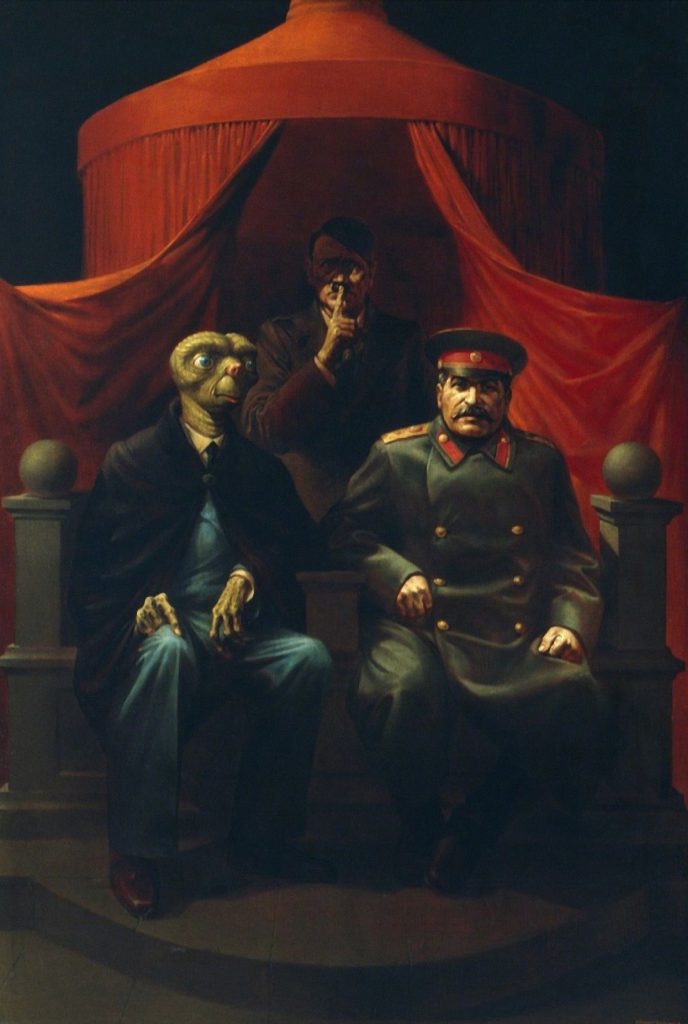
Komar and Melamid | Yalta Conference, 1982
January 26, 2023Komar and Melamid, Yalta Conference, from the “Nostalgic Socialist Realism” series, 1982
I enjoy speculative fiction and recently was reading Harry Turtledove’s Joe Steele. It’s a stand alone story, but you may be familiar with his Southern Victory series (in which the Confederate States survive the American Civil War, and it stretches into the mid twentieth century, offering alternate – yet familiar – takes on everything from WW I to the Holocaust) or World War / Colonization books. That series of books inject an alien invasion into the midst of WW II. This might sound ludicrous, until you read them and one of the aliens observes that – upon their discovery of Buchenwald and Auschwitz – that clearly humans are monstrously incapable of governing ‘ourselves.’ It’s an interesting tonic to the proliferation of science fiction that posits an alien deus ex machina that proffers the narrative that humans are special – such as Arthur C. Clarke’s Childhood’s End, for example. Perhaps it’s because Clarke was more hopeful, and much has happened since then…
“The novel [Joe Steele] explores what might have happened had Joseph Stalin been raised in the United States, postulating his parents having emigrated a few months before his birth, instead of remaining in the Russian Empire. It depicts Stalin (in this history, taking the name Joe Steele) growing up to be an American politician, rising to the presidency and retaining it by ruthless methods through the Great Depression, World War II, and the early Cold War. The president is depicted as having the soul of a tyrant, with Stalin’s real-world career mirrored by actions taken by Steele.” (from here)
But I mention Turtledove’s Joe Steele as it reminded me of Komar and Melamid’s painting Yalta Conference, from the Nostalgic Socialist Realism series, 1982. This work has also been the cover image for Boris Groys’ seminal book The Total Art of Stalinism: Avant-Garde, Aesthetic Dictatorship, and Beyond (2011). The ‘inspiration’ for this painting is a famous photograph.
Komar & Melamid are interesting for their cultivated personas as much as their art. This painting can’t help but offer and foment a myriad of interpretations, drawing upon not just the ‘players’ but the moment it re imagines. Yalta was, after all, the point at which the shaky alliance between the USSR and the United States began to seriously fracture. The employment – or appropriation – of ‘socialist realism’ (a style that was the official style of the USSR but that – to quote a Soviet born historian – was like Pravda, in that you can find some grain of truth by what it ignores) only makes this a ‘scene’ even more about failure (like the Yalta Conference was, towards any peace in a Post WW II world) than progress, with a sprinkling of absurdity and skepticism, with the hushing Hitler and American leader a goggle eyed alien….
Boris Groys, in writing about Komar and Melamid, offered the following about their aesthetic: “[The artists] themselves, however, perceive no sacrilege whatever here, because they consider the religion of the avant-garde to be false and idolatrous.”
More from Groys, that could also apply to this painting, and the multiplicities of potential interpretations of it (combined with the irreverence of Komar and Melamid’s larger practice): “[in] the West, the march of progress is “aimless” – one fashion succeeds another, one technical innovation replaces another and so on. The consciousness that desires a goal, meaning, harmony, or that simply refuses to serve the indifferent Moloch of time is inspired to rebel against this progress. Yet the movement of time has resisted all rebellions and attempts to confer meaning upon, control, or transcend it.”
More of Komar & Melamid’s work – and their unique aesthetic and legacy – can be enjoyed here. If you’re interested, more about Boris Groys’ writings and ideas can be read here.
~ Bart Gazzola
Read More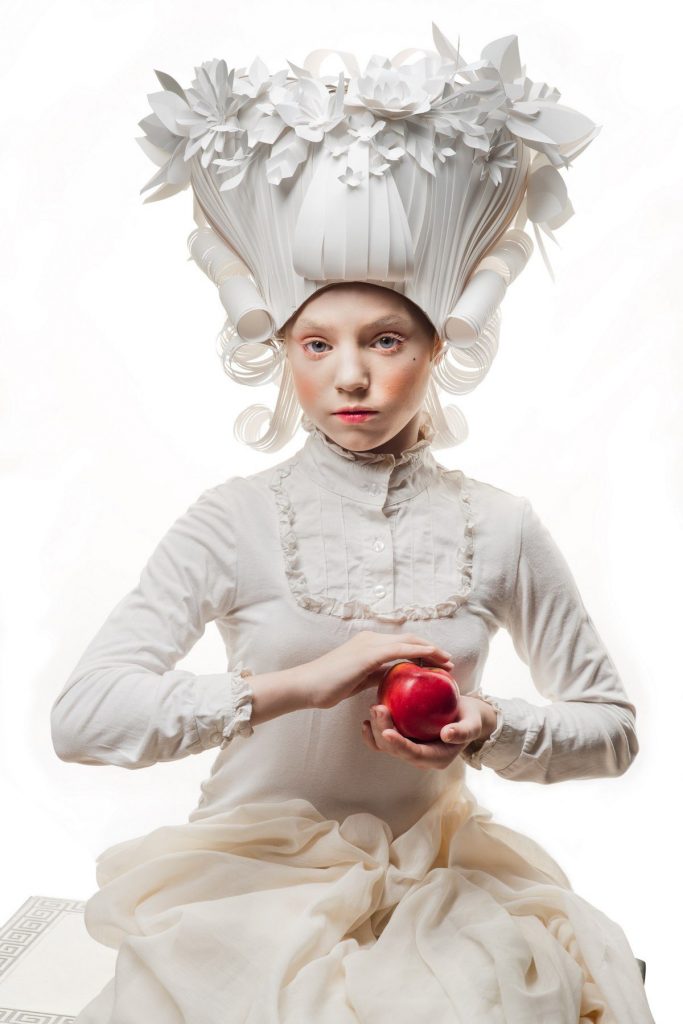
Asya Kozina | Baroque Paper Wigs, 2016
October 14, 2022Asya Kozina | Baroque Paper Wigs, 2016
Historical wigs always fascinated me, especially the Baroque era. This is art for art’s sake aesthetics for aesthetics, no practical sense. But they are beautiful. I made a series of wigs. Paper helps to highlight in this case the main form and not be obsessed [with] unnecessary details.
There is something both decadent and timeless about Kozina’s work. The idea of a peformative lens comes into play – as these intricate, hand made (with no digital tools) ‘wigs’ only attain their ultimate beauty when worn by one of Kozina’s models, and the rest of the team comes together (meshing together, perhaps, like the paper in the artist’s constructions) to produce a moment that has as much to do with art historical tropes, as seen in the paintings of Jacques Louis David or Caravaggio, as it does with contemporary couture and fashion. The artifice of the apple, the pale face perfectly dotted with subtle spots of rouge, the winsome look eschewing eye contact in one scene and the feigned precociousness of the model looking directly at us in another all suggest this might be a Jean-Honoré Fragonard (more late Baroque, with a touch of the playfulness of Rococo) except for the stark palette, only broken by the red of the apple.
I think of Fragonard as the old Russian Imperial court often looked to France for its ideal, and there’s a sentiment of the elaborate, exotic Ancien Régime to Kozina’s many works: another act of imitation from an artifice of pretension that was, of course, all about social class and cultural capital.
But Kozina does more than just mimic: several bodies of work – such as the more ballistic Baroque Punk or more erotic Eve – employ the history of fashion as a starting point for contemporary considerations and conversations.
More of her work can be seen on IG at @asya_kozina or at her site.
The photographer for this work is Anastasia Andreeva, with assistance from Dina Kharitonova. The makeup artists are Marina Sysolyatina and Svetlana Dedushkina.
~ Bart Gazzola
Read More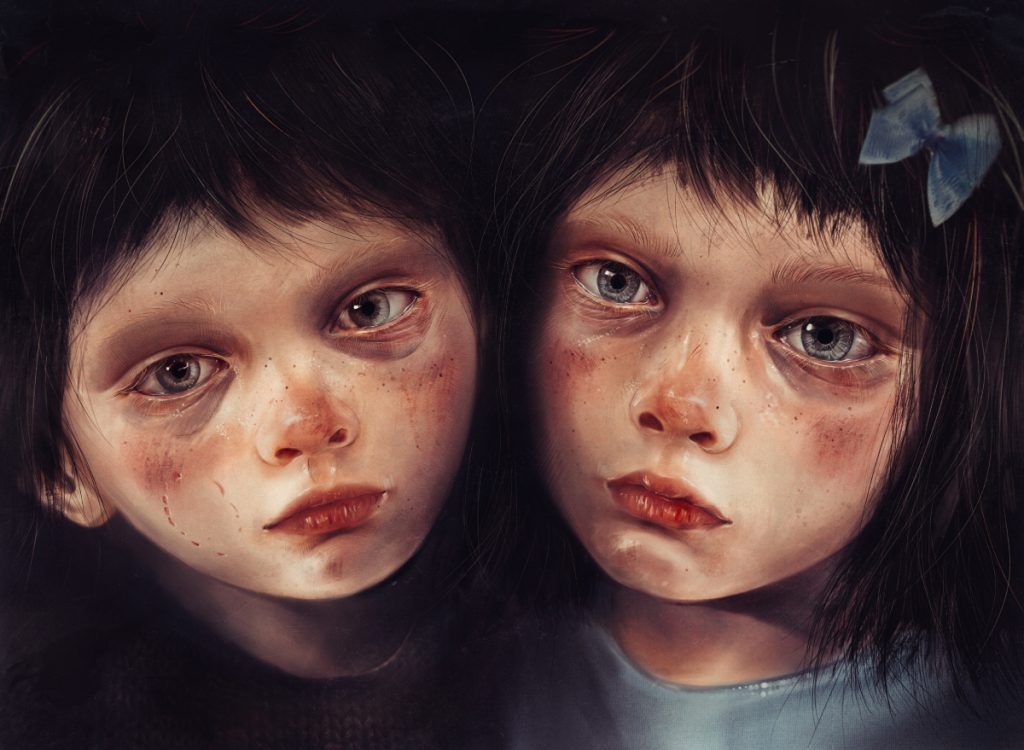
The Mark – Olga Volgina
August 24, 2021One of Olga Volgina’s more recent works that she’s shared on social media (as she’s a prolific artist) is a work that resonates in both an immediate and historical manner. Any (well made and meaningful) rendering of children has this power. Volgina’s children evoke a multiplicity of intersecting references: Goya’s portrait of Manuel Osorio Manrique de Zúñiga, who looks doll – like and innocent until a closer examination reveals several cats waiting to devour his pet bird, to the child’s indifference, is one. Delving even deeper into the worn faces and unflinching gaze of the children, I’m also reminded of Robertson Davies’ book World of Wonders. In response to one character relating his harsh yet essential childhood experiences, another defers that though he has experience “exploring evil” through his films, the evil of children is something that requires courage he lacks….
Volgina’s children must also bring to mind Ignorance and Want, from Dickens’ A Christmas Carol, and in that instance offer a more disturbing consideration of how a child is perhaps a larger reflection (or repository) for the world in which they live. Volgina commented that when this work – titled The Mark – was finished, “now I look at them and they look at me”, but what they see, or what they think, is opaque to us. We can guess; but the children in The Mark are silent and staring, offering no answers. Perhaps they’re indifferent to us, perhaps demanding, or perhaps simply exhausted and bruised.
Volgina lives and works in St. Petersburg, Russia. Her digital portraits, as she describes them, are both a bit unsettling and insightful. This brings to mind how sitting for some artists requires a degree of courage (never mind being nude but what of the deeper self that the artist might excavate and present for the world to see?).
See more of Olga Volgina’s work on Instagram, FB and at Etsy, where she and her twin sister, Liza Volgina, have a variety of engaging works on display. ~ Bart Gazzola
Read More
Recent Comments